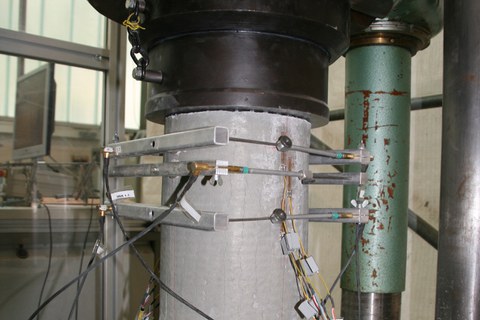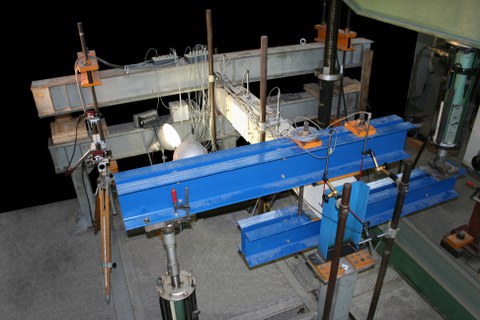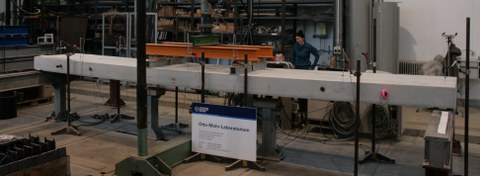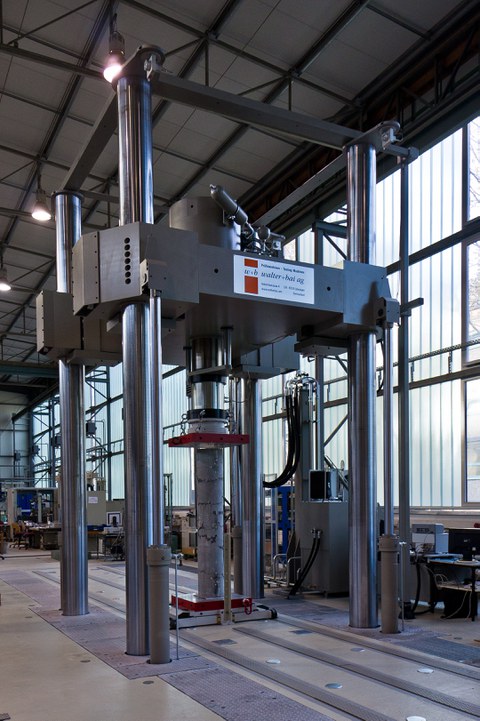Subproject D4
Strengthening of normal and torsion force exposed members with textile reinforced concrete
Director
Prof. Dr.-Ing.
Manfred Curbach
Institute of Concrete
Structures
Staff
Dr.-Ing.
Regine Ortlepp
Dipl.-Ing.
Frank Schladitz
Aim
The principal object is to depict the interaction between old concrete, steel reinforcement and textile concrete regarding a normal force and torsion strengthening.
Therefor firstly normal force tests at short columns (also called column heads) and about 2 m high columns are to be carried out. Both test specimen types are to be examined with round, rectangular and quadratic cross sections. The short columns are planned thus so as to conform to the load introduction area of a longer column.
The torsion tests are to conduct at about 2 m long columns with round and rectangular cross section.
After the tests engeneering models are to be developed in order to describe the load-bearing behaviour.
Concluding the transferability of the test results from small to large-sized components, as well as the predictive capability of the calculation models having been developed in SFB 528 have to be confirmed at large scale tests at columns.
Results
The studies having been conducted until the beginnings of 2011 include quadratic, round and rectangular reinforced concrete cross sections. The test specimen produced in the laboratory are being prewetted after roughening the surface. Afterwards they are strengthened with TRC in a hand laminating procedure. Beside the different reinforcement materials (alkali resistent glass (AR-Glass) and carbon) and differing reinforcement degrees (1-6 layers of textile reinforcement), the impact of variable edge fillets of the old concrete test specimen was also considered.
Compressive test machines (Figure 1) and even a self-developed torsion test fence are used for the tension tests. The measuring of the load-dependent deformation during the tests is carried out through strain gauges, inductive displacement transducers and photogrammetic measurement procedures.
Normal force strengthening
The old concrete cross section of the column formed test specimen were wrapped with stripes of textile fabric in the corresponding length. After fully covering it a thin fine-grained concrete layer was applied.
All tests depicted in part considerable collapse load increases compared to the unstrengthened reference specimen. This augmentation is being composed from two parts. The first one is based on the enlarging column cross section resulting from the additionally applied fine-grained concrete layer, the second one on a confinement effect due to the wrapping with TRC. This confinement creates a three axial state of stress in the concrete core of the column and leads thus to a considerable raise of the load-carrying capacity. The results of the examinations at round columns clearly account for this confinement effect. At the angular columns it could be proven that the confinement effect augments with a growing radius of the edge fillets. It furthermore increases with an accumulating reinforcement degree.
Torsion strengthening
At the torsion loaded test specimen the textile reinforcement was positioned in an angle of 45°. Thus the strengthening filaments were orientated corresponding to the main stress direction of pure torsion.
Through the possibility of applying the textile reinforcement parallely to the tensile force the stiffness and thus the usability is being increased considerably (beside the augmentation of the load bearing capacity of up to three times the unstrengtehened reference one´s). With increasing reinforcement degree load-carrying capacity and stiffness raise as expected. The enlarging test specimen cross section further add to the rise of the load bearing capacity of the compression strut. Furthermore the TRC strengthening realises a clear decrease of the crack widths and crack spacing which also affects the usability positively.
Large scale tests at slabs
The tested 7,0 m long, 1,0 m wide and 0,23 m thick reinforced concrete slabs corresponded the real dimensions in the building. The lower flexural tensile reinforcement consisted of 5 Ø 12 with a spacing of 20 cm. The transverse reinforcement was also formed by Ø 12. The concrete cover was 25 mm. Before the strengthening the reinforced concrete slabs were sand blasted so as to secure a rough bonding joint. After the prewetting the TRC was applied by layers. Carbon fabric SGL Grid 600 having a considerably higher yarn cross section than the yarns used until now was applied.
Beside the unstrengthened reference slab four strengthened slabs with one to four layers of textile reinforcement were examined within a four point bending test (figure 3). The span width was 6,75 m, the distance between the load introduction points 1,5 m. As expected considerably higher load bearing capacities could be verified for the TRC strengthened concrete slabs. The load carrying capacity incerased constantly with a growing layer number until 3.5 times (with 4 layers of textile carbon strengthening) of the unstrengthened reference slab. At the same time the deflections decrease with equal load level and growing layer number. The comparison of the experimentally and calculatively determined load bearing capacities showed a difference of less than 10 %. Thus the applicability of the bending measurement models developed beforehand could be verified also for components with large span widths and high reinforcement degrees.
Large sclae tests at columns
From the small scale tests a measurement model was developed enabling the prediction of the load bearing capacity of reinforced normal force loaded columns. The accuracy of this prediction for columns with practical measurements was being examined experimentally at three reinforced concrete columns with round cross sections (figure 4). The columns were 2 m high and had a diameter of 30 cm. One column stayed unstrengthened and served as a reference. Two more columns were reinforced with 5 layers of TRC throughout their total height whereas one of them was further reinforced at its head and base. Carbon was used for the reinforcement.
The bearing capacity of the TRC strengthened columns increased about 100% compared to the unstrengthened ones matching the prediction. Thus it could also be proven that the developed confinement model can display reality very well. The achievable bearing capacity increase until the failure of the column core is basically dependent on the normal force part of the fine-grained concrete. After this core failure a frictional bond between fine-grained concrete cover and core concrete emerges probably resulting from the increasing lateral strains. Thus the tied part of the fine-grained concrete cover is being newly activated and further longitudinal forces can be cut over the textile reinforcement cover. This mechanism further adds to the confinement of the core concrete and the collapse load increase.
Beside the augmentation of the load bearing capacity the textile reinforced strengthening resulted in a considerable improvement of the advance notice behaviour. During the load increase fine and lateron clearly visible, even cracks formed. In the further course of the load raising the approach to the ultimate load became clearly visible through the flaking of the concrete cover. All in all a high ductility of the columns was achieved.
Publications
2011
- Curbach, M.; Ortlepp, R.: Leichtes Bauen mit ultrahochfesten und Textilbetonen. In: Bauforschung und Baupraxis, Heft 10: “Wie wollen wir in Zukunft bauen?” – Festschrift zum 60. Geburtstag von Prof. Dr.-Ing. Wolfram Jäger, Dresden, 19.04.2011. S.17-22 - ISBN 978-3-86780-216-1
2010
2009
- Schladitz, F.; Curbach M.: Torsionsversuche an textilbetonverstärkten Stahlbetonbauteilen. Beton- und Stahlbetonbau 104 (2009) 12, S. 835-843 – doi:10.1002/best.200900043
- Curbach, M.; Ortlepp, R.: Verstärkung von Stützen mit textilbewehrtem Beton. BFT INTERNATIONAL Betonwerk + Fertigteiltechnik 75 (2009) 2, S. 176–177
- Ortlepp, R.; Schladitz, F.; Curbach, M.: TRC-Strengthening for Normal and Torsion Loads. In: Kuczma, M. (Hrsg.); Wilmanski, K. (Hrsg.); Szajna, W. (Hrsg.): Proceedings of the 18th International Conference on Computer Methods in Mechanics – CMM2009, Zielona Góra, 18.–21.5.2009. Zielona Góra : The University of Zielona Góra Press, 2009, S. 345–346 – ISBN 978-83-7481-245-0
- Curbach, M.; Jesse, F.: Eigenschaften und Anwendung von Textilbeton. In: Beton- und Stahlbetonbau 104 (2009) 1, S. 9-16 – doi:10.1002/best.200800653
- Schladitz, F.; Curbach, M.: Textilbewehrter Beton als Torsionsverstärkung. In: Curbach, M. (Hrsg.), Jesse, F. (Hrsg.): Textile Reinforced Structures : Proceedings of the 4th Colloquium on Textile Reinforced Structures (CTRS4) und zur 1. Anwendertagung, Dresden, 3.-5.6.2009. SFB 528, Technische Universität Dresden, D–01062 Dresden : Eigenverlag, 2009, S. 421-432 – ISBN 978-3-86780-122-5 URN: urn:nbn:de:bsz:14-ds-1244048995744-78708
- Ortlepp, R.; Curbach, M.: Verstärken von Stahlbetonstützen mit textilbewehrtem Beton. In: Beton- und Stahlbetonbau 104 (2009) 10, S. 681-689 – doi:/10.1002/best.200900034
- Ortlepp, R.; Lorenz, A.; Curbach, M.: Column Strengthening with TRC: Influences of the Column Geometry onto the Confinement Effect. Advances in Materials Science and Engineering 2009 (2009) Article ID 493097, 5 pp. – doi:10.1155/2009/493097
2008
- Schladitz, F.; Curbach, M.: Textile Reinforced Concrete (TRC) as Torsion Strengthening. In: 17th Congress of the International Association for Bridge and Structural Engineering Congress (IABSE), Chicago, 17.-19.09.2008. – CD-Rom – Book of Abstracts, pp. 452-453 and CD-ROM – ISBN 978-3-85748-118-5
2007
- Ortlepp, S.; Ortelpp, R.; Curbach, M.: Experimental Investigations on Columns Strengthened by Using Textile Reinforced Concrete. In: Proceedings of the Third International Conference on Structural Engineering, Mechanics and Computation (SEMC 2007), Cape Town, 10.–12.09.2007. – submitted for publication
2006
- Curbach, M.; Ortlepp, R.; Triantafillou, T. C.: TRC for rehabilitation. In: Brameshuber, W. (Hrsg.): Textile Reinforced Concrete : State-of-the-Art Report of RILEM Technical Committee 201 – TRC: Textile Reinforced Concrete. Bagneux : RILEM, Report 36, 2006, S. 221–236 – ISBN 2-912143-99-3
- Al-Jamous, A.; Ortlepp, R.; Ortlepp, S.; Curbach, M.: Experimental investigations about construction members strengthened with textile reinforcement. In: Brameshuber, W.; Hegger, J.; Will, N. (Hrsg.): 1st International Conference Textile Reinforced Concrete (ICTRC), Aachen. Institute of Structural Concrete, RWTH Aachen University, 2006. S. 161-170
2005
- Curbach, M.; Jesse, F.: Verstärken von Stahlbetonbauteilen mit textilbewehrtem Beton - Kurzer Bericht zu aktuellen Entwicklungen. In: Beton- und Stahlbetonbau 100 (2005) S1, 78-81 – doi:10.1002/best.200590174
2004
- Curbach, M.; Hegger, J.: Editorial: Textilbewehrter Beton. Eine vielversprechende Neuentwicklung. In: Beton- und Stahlbetonbau 99 (2004) 6, 437 – doi:10.1002/best.200490132




